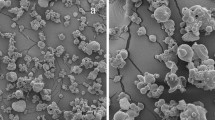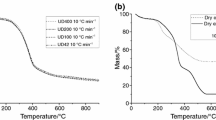Abstract
Thermogravimetric (TG) techniques and differential scanning calorimetry (DSC) used for the study of pre-formulation or drug–adjuvant compatibility have been gaining importance in Brazil. These techniques are being used for the verification of possible interactions between drugs and adjuvants. Aiming at studying the behavior of a plant extract and its mixture with adjuvants, using these thermoanalytical techniques the plant species Heliotropium indicum L. was used. This plant which is originally from India and has been well acclimatized in Brazil has healing and anti-inflammatory properties. The methodology for obtaining the extract followed the Brazilian Pharmacopoeia methodology. And the incorporation of the extract with adjuvants was through binary mixtures (1:1 w/w). The TG and DSC curves were obtained under nitrogen atmosphere (25 mL min−1) at a heating rate of 5 °C min−1; TG tests were analyzed within a temperature range from 25 to 600 °C and DSC from 25 to 300 °C. The TG curves show good thermal stability of the extract and its mixtures with adjuvants up to 150 °C, except the propylene glycol (PLG). The DSC curves revealed an incompatibility of the extract with methylparaben and PLG mixture.




Similar content being viewed by others
References
Lorenzi H, Matos FJA. Plantas Medicinais no Brasil Nativas e Exóticas. Nova Odessa: Instituto Plantarum; 2002.
Melo JIM, Semir J. Taxonomia do gênero Heliotropium L. (Heliotropiaceae) no Brasil. Acta Bot Bras. 2008;22(3):754–70.
Di Stasi LC, Hiruma-Lima CH. Plantas Medicinais na Amazônia e na Mata Atlântica. 2nd ed. São Paulo: Editora UNESP; 2002.
Reddy JS, Rao RP, Reddy MSJ. Wound healing effects of Heliotropium indicum, Plumbago zeylanicum and Acalypha indica in rats. J Ethnopharmacol. 2002;79:249–51.
Wadke DA, Serajuddin ATM, Jacobson H. Preformulation testing. In: Lieberman HA, Lachman L, Schwartz JB, editors. Pharmaceutical dosage forms: tablets, vol. 1. New York: Marcel Dekker; 1990. p. 1–73.
Ochoa MDV, Alegre MEG, Duran JT. Preformulacion. In: Vilajato JL, editor. Tecnologia farmacêutica. 1st ed. Madrid: Síntesis; 2001. p. 27–73.
Wells JI. Pharmaceutical preformulation: the physicochemical properties of drug substances. Chichester: Ellis Horwood; 1993.
Wells JI. Pharmaceutical preformulation: the physochemical properties of drug substances. In: Aulton ME, editor. Pharmaceutics, the science of dosage form design. 2nd ed. London: Churchill Livingstone; 2002. p. 114–38.
Salvio Neto H, Novak Cs, Matos JR. Thermal analysis and compatibility studies of prednicarbate with excipients used in semi solid pharmaceutical form. J Thermal Anal Calorim. 2009;97:367–74.
Felsner ML, Matos JR. Análise da Estabilidade Térmica e Temperatura de Oxidação de Óleos Comestíveis Comerciais por Termogravimetria. An Assoc Bras Quim. 1998;47:308–18.
Aragão CFS, Souza FS, Barros ACS, Veras JWE, Barbosa Filho JM, Macedo RO. Aplicação da termogravimetria (TG) no controle de qualidade da milona (Cissampelos sympodialis Eichl.) Menispermaceae. Rev Bras Farmacogn. 2002;12:60–1.
Oliveira FF, Paola MVR, Matos JR. Análise Térmica Aplicada Aos Produtos Cosméticos. Cosmeics Toiletries. 2004;16:52–4.
Alves TVG, Tavares EJM, Aouada FA, Negrão CAB, Oliveira MEC, Duarte Júnior AP, Da Costa CEF, Silva Júnior JOC, Ribeiro-Costa RM. Thermal analysis characterization of PAAm-co MC hydrogels. J Therm Anal Calorim. 2011;106:717–724.
Santos AL, Chierice GO, Alexander KS, Riga A. Characterization of the row essential oil eugenol extracted from Syzygium aromaticum L. J Therm Anal Calorim. 2009;96:821–5.
Martin AN, Bustamante P, Chun AHC. Physical pharmacy. 5th ed. Philadelphia: Lea & Febiger; 1993.
Florence AT, Atwood D. Physicochemical principles of pharmacy. 3rd ed. London: MacMillar Press; 2003.
Brown ME. Introduction to thermal analysis. Techniques and applications. Dordrecht: Kluwer; 2001.
Hatakeyma T, Quinn FX. Thermal analysis an application to polymer science. 2nd ed. Chichester: Wiley; 1999.
Kopelman SH, Augsburger LL. Excipient compatibility study of Hypericum perforatum extract (St. John’s Wort) using similarity metrics to track phytochemical profile changes. Int J Pharm. 2002;237:35–46.
De Medeiros ACD, De Medeiros I, Macedo RO. Thermal studies of Albizia inopinata crude extract in the presence of cyclodextrina and Aerosil® by TG and DSC coupled to the photovisual system. Thermochim Acta. 2002;393:93–8.
Farmacopéia Brasileira. 4 ed. São Paulo: Atheneu; 1988.
Farmacopéia Brasileira. 2nd ed. São Paulo: Indústria Gráfica Siqueira; 1959.
Wesolowski M, Suchacz B, Konieczynski P. The application of artificial neural networks for the selection of key thermoanalytical parameters in medicinal plants analysis. Comb Chem High Throughput. 2003;6:811–20.
Araújo AAS, Mercuri LP, Seixas SRS, Storirtis S, Matos JR. Determinação dos teores de umidade e cinzas de amostras comerciais de guaraná utilizando métodos convencionais e análise térmica. Rev Bras Cienc Farm. 2006;42:269–77.
Singh JP, Pandey DP, Pandey MB, Singh A, Singh R. Alkaloids of Heliotropium indicum. J Indian Chem Soc. 2005;82:175–6.
Souza JSN, Machado LL, Pessoa ODC, Braz-Filho R, Overk CR, Yao P, Cordell GA, Lemos TLC. Pyrrolizidine alkaloids from Heliotropium indicum. J Braz Chem Soc. 2005;16:1410–1.
Castillo J. Determinacion de Metabolitos Secundários en Plantas Silvestres Del Parque Nacional Terepaima, Municipio Paravencino, Estado Lara, Tessis. Universidad Centro occidental Lisandro Alvarado, Venezuela, 2004.
Costa RS. Estudos de Pré-formulação e Formulação de Heliotropium indicum (L.) DC (Boraginaceae). Belém: Universidade Federal do Pará; 2010.
Costa RS, Camelo SRP, Ribeiro-Costa RM, Barbosa WLR, Vasconcelos F, Silva Junior JOC. Physical, chemical and physical-chemical controlo f Heliotropium indicum Linn., boraginaceae, powder and tincture. IJPSR. 2011;2(8):2211–6.
Costa TMS, Martinelli JR, Matos JR. Análise térmica aplicada a estudos de ecoeficiência do bambu para processos de carbonização. CBECiMat, 2004.
Kibbe AH, editor. Handbook of pharmaceutical excipients. 3rd ed. London: Pharmaceutical; 2000.
Budavari S, editor. The Merck Index. 12th ed. Write House Station: Merck; 1996.
Mura P, Faucci MT, Manderiolli A, Furlanetto S, Pinzanti S. Thermal analysis as a screening technique in preformulation studies of picotamide solid dosage forms. Drug Dev Ind Pharm. 1998;24:747–56.
Acknowledgements
The authors thank the Coordination of Improvement of Higher Education Personnel (CAPES), the Research Support Foundation of the State of Pará (FAPESPA), the Research and Development Foundation (FADESP) and Dean of Graduate Studies and Research (PROPESP/UFPA).
Author information
Authors and Affiliations
Corresponding author
Rights and permissions
About this article
Cite this article
da Costa, R.S., Negrão, C.A.B., Camelo, S.R.P. et al. Investigation of thermal behavior of Heliotropium indicum L. lyophilized extract by TG and DSC. J Therm Anal Calorim 111, 1959–1964 (2013). https://doi.org/10.1007/s10973-011-2088-2
Received:
Accepted:
Published:
Issue Date:
DOI: https://doi.org/10.1007/s10973-011-2088-2




